Last updated on
Your interest in football will find a stylish expression in your home, because this article provides some of the most creative football chalkboard ideas to decorate your spaces.
I’ve designed unique illustrations for these ideas. I hope you get inspired!
Football chalkboards are versatile, multifunctional, and brimming with possibility. Though the internet is spilling over with ideas already, the goal is to venture off the beaten path, revealing a treasure trove of burnt-orange gems waiting to be discovered.
The finished collection will not only include a bucket load of fresh, unique ideas viewed from intriguing angles, but also serve as a comprehensive resource, meticulously connecting the dots to the best of conventional ideas pursued in the past.
So fasten your creativity seatbelts, because it’s time to redefine the narrative of football chalkboard artistry.
Chalkboard Playing Field Diagrams
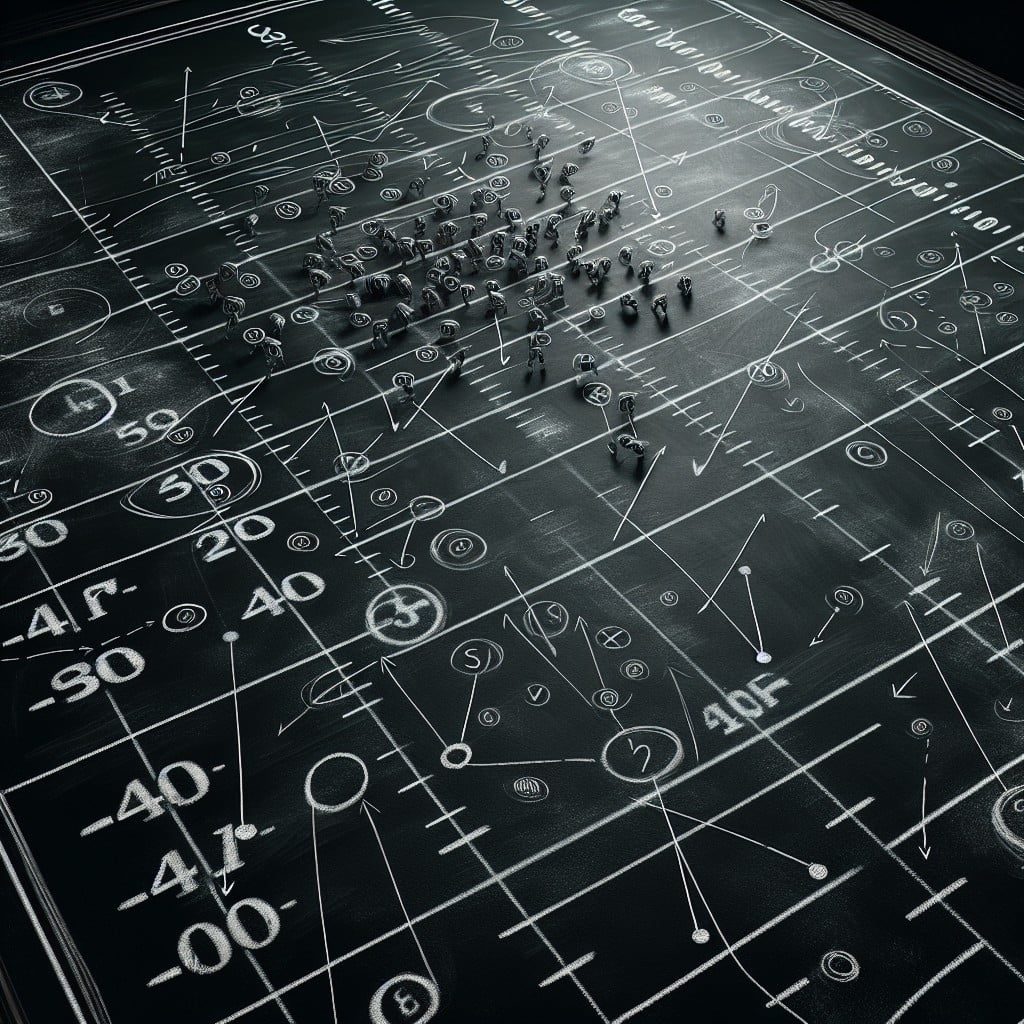
Creating a chalkboard playing field diagram is a fun and interactive approach to understanding the dynamics of the game. All you need is a chalkboard and some colored chalks to create a scaled representation of the field.
Here are a few pointers:
- Use white chalk to define the field boundaries and yard lines, replicating a real football field’s layout.
- Different colored chalks can distinguish teams, positions, and movements. For example, use red and blue to designate team A and team B.
- Xs and Os typically represent players. Incorporate arrows to signify directions of movement, such as running routes or passes.
- Don’t forget essential elements such as end zones, goal posts, and the 50-yard line.
- Always erase and revise the diagram as you discuss different tactics, formations, and play scenarios.
Remember, your chalkboard playing field diagram is a dynamic learning tool. It’s not meant to be an art masterpiece. Instead, it should spark curiosity, provide clarity, and enhance the football-watching experience.
Tactics and Strategies Analysis
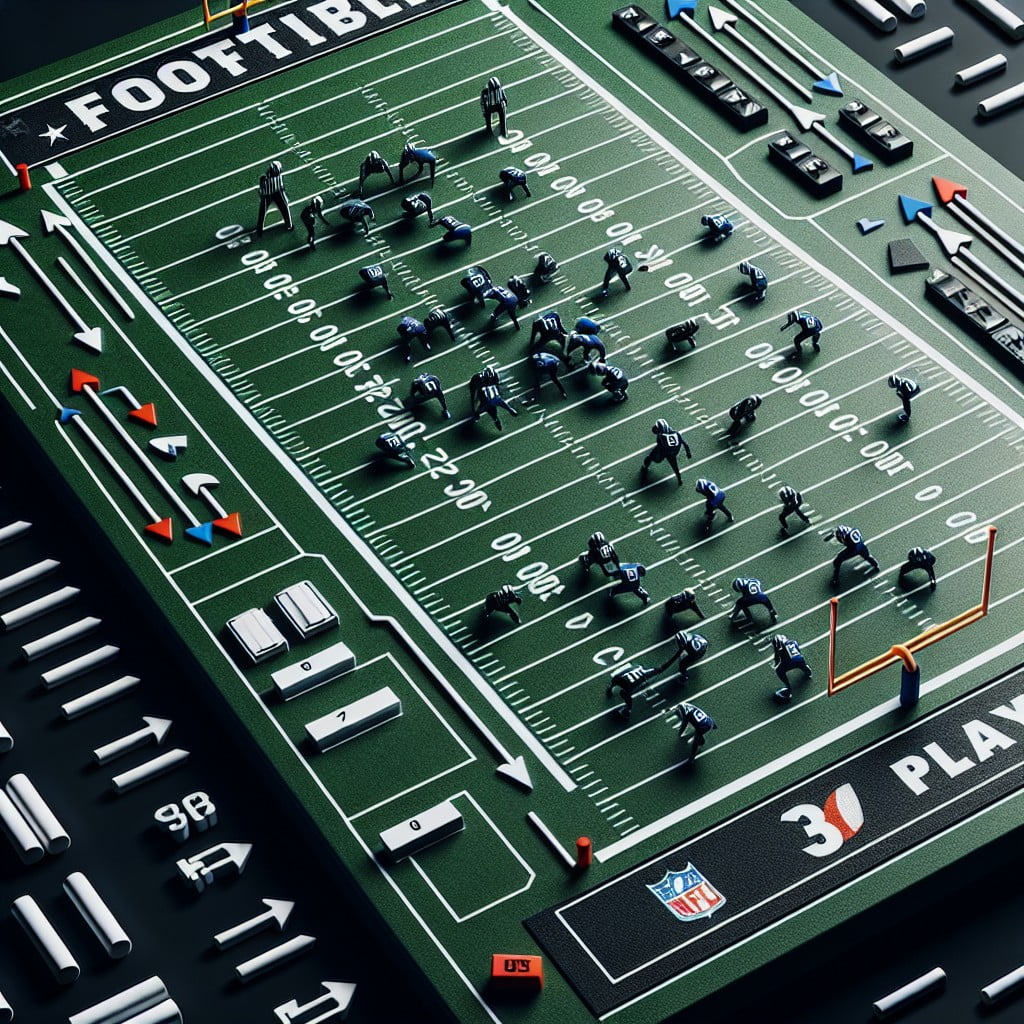
Having a clear representation of tactics and strategies can provide a profound understanding of football intricacies. A chalkboard is an excellent tool for visualizing different elements from well-known formations to intricate game plans.
1. Football Formations: Sketch commonly used formations like the 4-3-3 or 3-5-2. Understand the roles and positions of players within these formations.
2. Key Strategies Analysis: Highlight offensive and defensive strategies, such as counter-attacks and using wing-backs to support both defense and attack.
3. Set Piece Planning: Visualize set pieces like corner kicks, free kicks, and penalties. Discuss the positioning of players and why it matters.
4. Pressing Techniques: Explore different styles including high pressing and low block, explaining the pros and cons of each.
5. Positional Switching & Rotation: Demonstrate how players rotate and interchange positions during the game.
6. Understanding Space & Time: Emphasize how to exploit space and time during a match to gain advantage over the opposition.
7. In-Game Adjustments: Discuss how tactics can shift during the game based on the current scoreline or opposition behavior.
Remember, the aim is not just to recognize these concepts, but to articulate and use them in real game scenarios.
Famous Football Plays Diagrams

In the world of football, some plays are legendary, remembered for their masterful demonstration of skill and strategy. Transcribing these iconic moments onto a chalkboard can provide an educational, interactive, and engaging piece.
1. Player Positioning: By intricately tracing the routes of each player, understand the precision needed in a sport like football.
2. Strategic Analysis: Highlighting key movements and decisions in these plays can lead one to appreciate the strategy behind the sport.
3. Visual Interpretation: A play diagram doesn’t only show what happened, but also presents an opportunity to interpret and discuss the possibilities of different outcomes.
4. Skill Recognition: Reviewing such famous plays can help identify the skills displayed by each player, inspiring enthusiasts and aspiring players.
5. History Appreciation: Each famous play comes with a story, understanding them deepens the appreciation for football’s rich history.
Remember, the aim of diagramming famous football plays isn’t just to present special moments, but to delve deeper into the beauty and complexity of football.
Match Day Countdown

Keeping track of match dates can create added excitement in the run-up to the big game while helping everyone stay organized and on top of events. It’s easy to get started – simply dedicate a section of the chalkboard to the upcoming matches.
i. Find a calendar template online and mimic it on the chalkboard, or better still, create your style.
ii. List down the dates, opponents, and possible locations.
iii. Update match scores promptly after each game.
iv. For an interactive approach, initiate a guessing game about the game’s outcome and reward correct predictions.
v. You can incorporate visual elements like team logos or little football doodles next to each match for a lively touch.
With such a system, no one in your household will miss a match, making a countdown an integral aspect of your football chalkboard.
Football Jargon Glossary

Downs, field goals, blitzes, or Hail Marys may seem like foreign terms to those new to football. However, understanding these words can significantly enhance your enjoyment of the game.
Firstly, ‘downs‘ are attempts a team has to advance the ball 10 yards or more. A ‘field goal‘ happens when a player kicks the ball through the opponent’s goalposts.
Meanwhile, a ‘blitz‘ is a strategic move where additional players are sent to tackle the quarterback. This tactic aims to interrupt a pass or to keep the opposition on the defense.
Lastly, a ‘Hail Mary‘ is a play in which the quarterback throws the ball as far as possible with the hope that a teammate downfield will be able to catch it. This term typically relates to plays made during desperate times or at the end of a game.
Thus, familiarizing oneself with these pieces of jargon will greatly enrich your understanding and appreciation of football, transforming you into an assured spectator or an informed player. This glossary sets the foundation for both discussing and breaking down strategies and player performances on a deeper level.
Season Schedule and Countdown

Knowing when to tune in for each exciting play is fundamental for any avid football fan. A chalkboard dedicated to tracking your favorite team’s season schedule is not just decorative, but also highly functional. Begin with a basic calendar structure and list the monthly fixtures. Highlight the most anticipated matches with eye-catching chalk colors to ensure you’re ready for the big games.
A chalkboard countdown to significant seasonal events builds anticipation and joy in the home. Simply tally off the days leading up to the Super Bowl, the first game of the season, or the local derby. The kids might enjoy joining in this daily task, making it a fun family ritual.
For football enthusiasts who follow players, not just teams, try noting down key players’ birthdays or the date of their upcoming special games. It’s a simple way to connect on a personal level with your football heroes.
Remember to update your chalkboard after each match with results, making it a living history of your team’s season. You’ll appreciate the journey when you observe the highs, lows, and progress your team has made throughout their campaign.
This dynamic way of displaying football information engages both young and adult football spectators beyond game days, fueling conversation and fostering a shared sense of excitement. It’s a game-changer for your football-themed home decor while keeping you connected with the sport you love.
Chalkboard Fantasy Football Draft Tracker
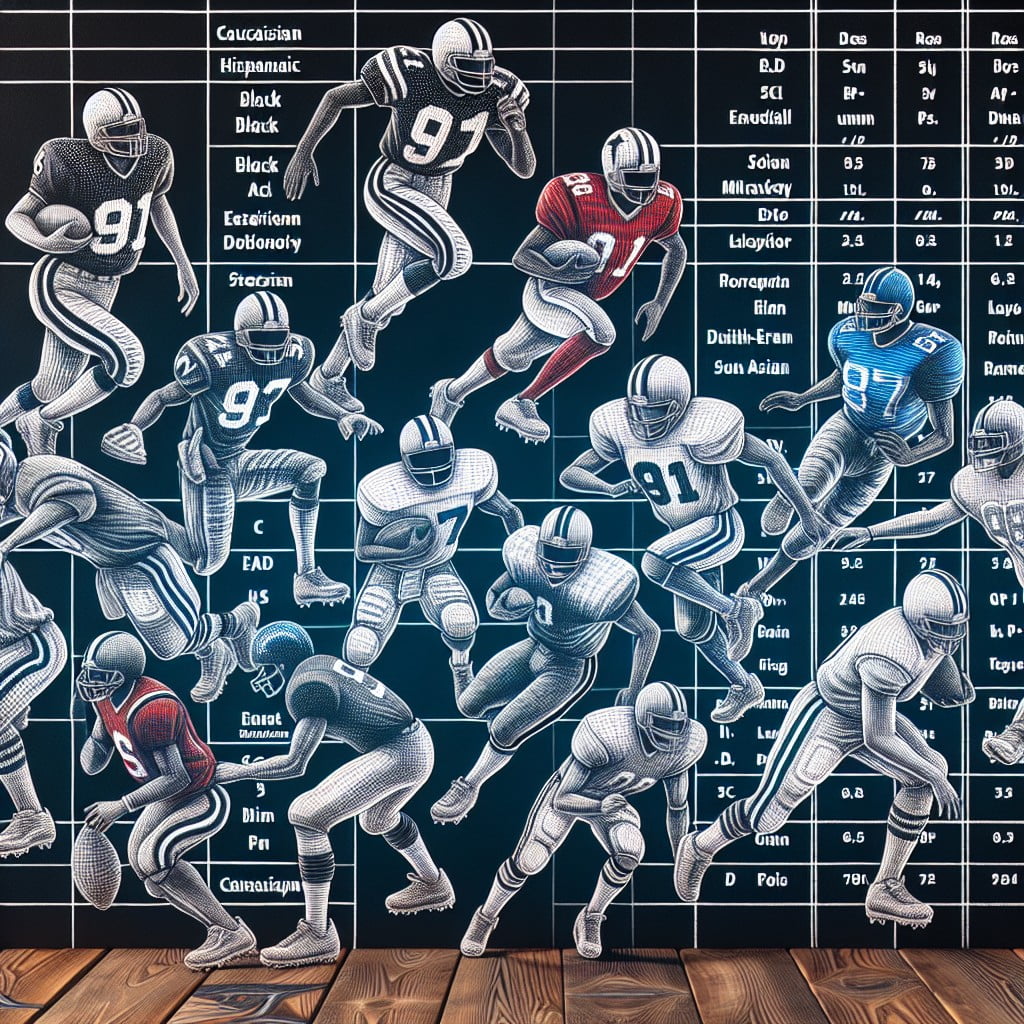
Through a chalkboard draft tracker, fantasy football becomes a living, tangible experience. Shaped by real-time energy, the play is not merely a digital event now. Transforming a simple board into a strategic masterpiece becomes an event within itself, calling for anticipation, quick-thinking, and competitive banter.
1. Use chalk pens of various colors to create a vibrant and easily distinguishable visual representation of your teams.
2. Maintain columns for each team and rows for each round of drafting. This will assist in keeping easy track of which team has picked which player.
3. Include a space for each player’s position in the NFL, their last-known stats and the reasoning behind their selection to your team.
4. Update your board during the season. When trades or injuries occur, it could be just as exciting, keeping the thrill alive between all players.
Remember, this chalkboard is not just about function but also about form, becoming a visually appealing testament to your fantasy football prowess. It’s time to bring the digital game into the physical realm, and this is your first strategy play. It’s more than technicalities; it’s about living the dream team!
Family Football Pool Board

Creating a Family Football Pool Board offers a thrilling way to get everyone involved in the game. This activity requires only a chalkboard, some colored chalk, and an understanding of the upcoming games.
Here’s how it works:
1. Divide the Board: Split the chalkboard into squares, enough for the number of participants. Assign one square to each person in the pool.
2. Make Your Predictions: Each person then writes their game predictions in their square. This could be the final score, the first touchdown, or any other entertaining guess.
3. Follow the Game: As the football match progresses, track the outcomes on the chalkboard.
Remember, this isn’t just about the competition; it encourages lively discussions and interactions, sparking excitement throughout the game.
‘Play of the Week’ Highlight
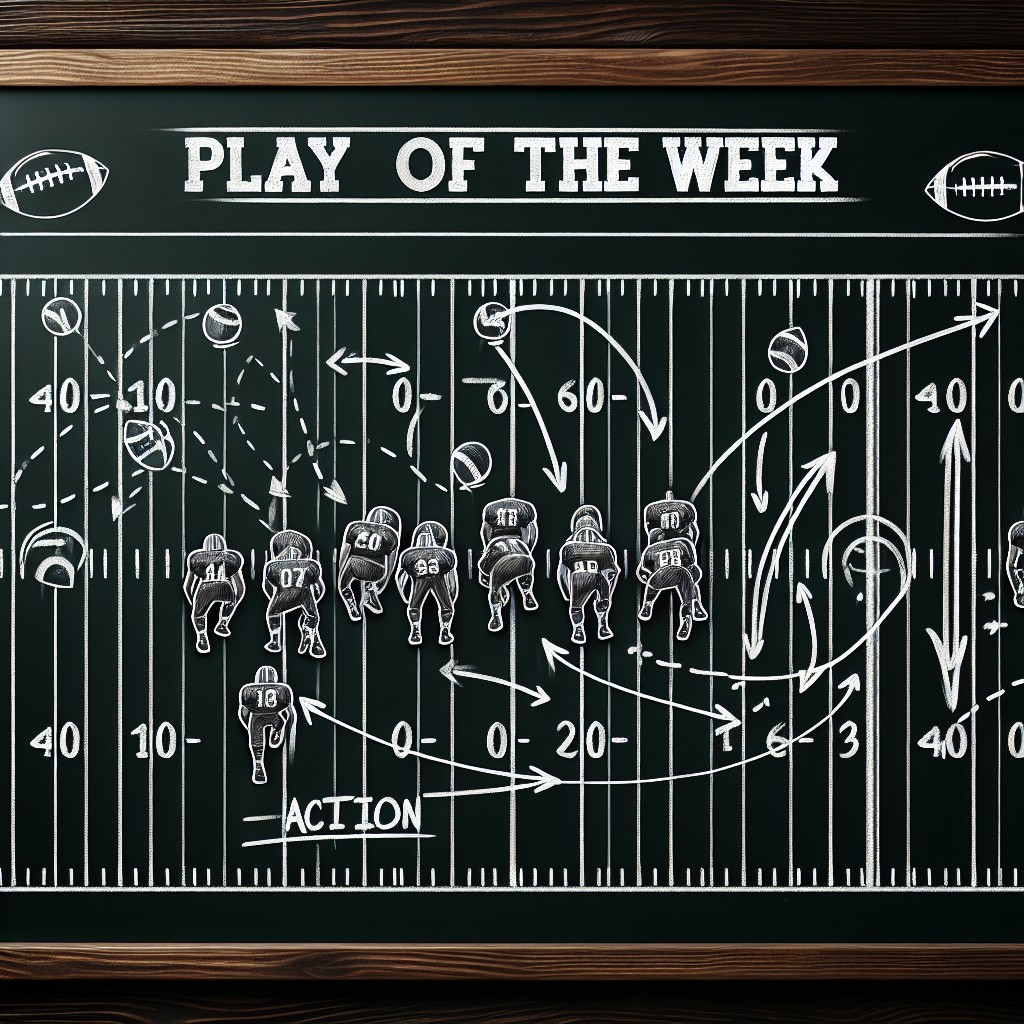
Hold a weekly contest that invites family members or friends to nominate what they believe was the standout play over the past seven days of football action. Define the parameters – it doesn’t have to be a touchdown, it could be an amazing catch, a decisive interception or even a particularly strong defensive move.
Scribble the chosen play on the chalkboard, complete with arrows, lines, and X’s and O’s. If you’ve got the space, why not add a short description and the name of the player who carried it out? It’s a fantastic way to celebrate individual brilliance, spark debates, and relive the week’s events.
Plus, this activity can be an excellent learning opportunity for the younger football fans among you who want to improve their knowledge of the game’s tactics. Remember to keep it fun, engaging, and respectful.
Draw and Predict the Game Winning Play
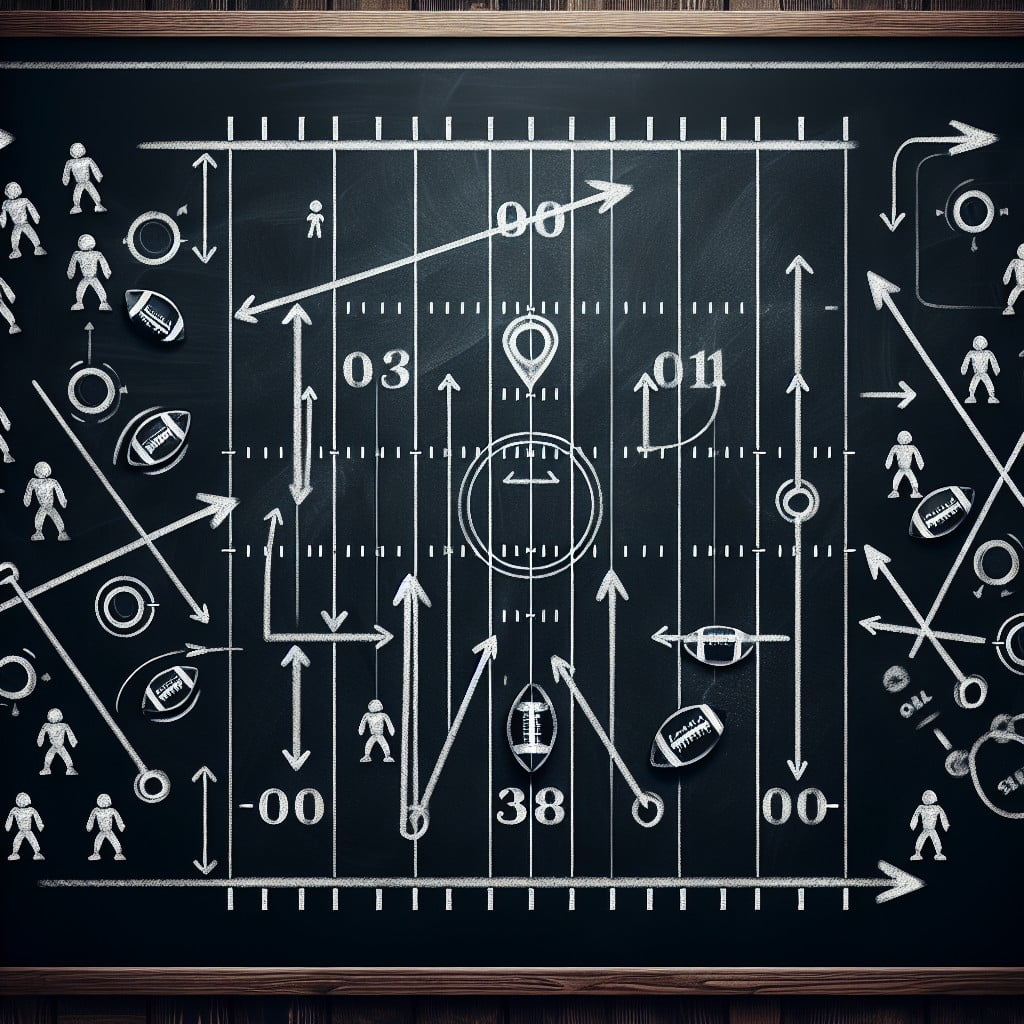
Engaging in drawing and predicting can ignite an analytical and exciting vibe within football fans. Here are steps to follow:
1. Understand the Current Game Scenario: Take note of the current scoreline, substances like respective team form, and the game’s progress to logically analyze and predict.
2. Consider the Team Strategies: Is one team a heavy attacker while the other is playing a defensive strategy? These parameters can help accurately map out the potential game-winning play.
3. Draw It Out: Break down the game-winning strategy into a play, depicting the potential player movements, passes, and potential goal-scoring opportunities. Use arrows and X/O representations for players to visualize the action easier.
4. Wait for the Moment: Hold on to your prediction and see if it materializes during the match. Remember, football can be unpredictable, but this exercise is fun and mentally stimulating.
Remember, football isn’t always about winning, it’s about enjoying the game and having fun with these activities. Making predictions can be more than a game—it’s an opportunity to learn and appreciate the game’s intricacies. Every prediction is a step towards understanding football better, so keep drawing, guessing, and relishing every move.
DIY Football Formation Learning
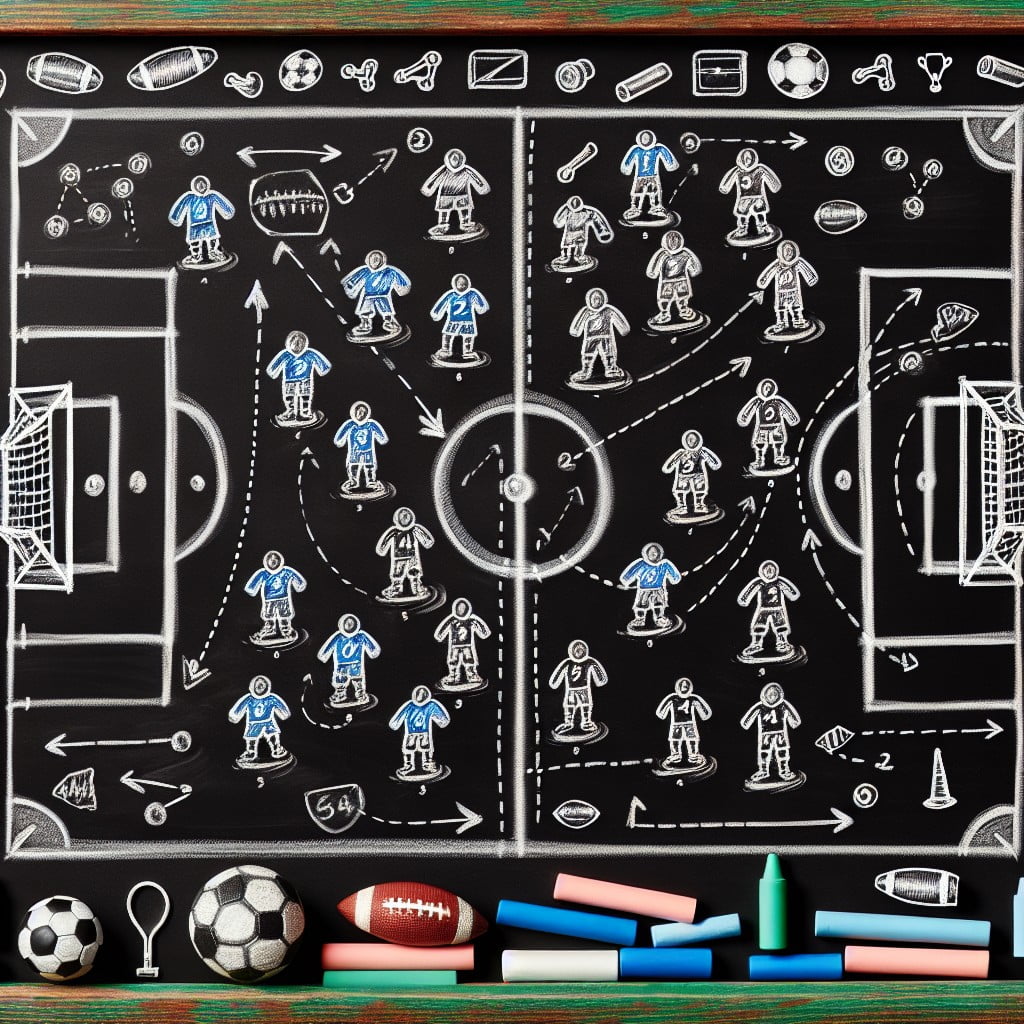
Embarking on this creative project allows both adults and children to engage with football on a deeper level. First, gather necessary materials: a sizeable chalkboard, multi-colored chalk, a damp cloth for corrections, and a ruler.
Step one involves drawing a basic football field. All 100 yards, end zones included. Make sure your lines are straight and proportions are correct for a realistic representation.
Next, introduce the positions. Colorful chalk assists in distinguishing between quarterbacks, wide receivers, linebackers, safeties, among other roles. Develop a color key for clarity.
Once the foundation is in place, move on to formation explanations. A visual aid benefits learners immensely. Start with simple offensive and defensive formations, such as the I-Formation or the 4-3 defense. As familiarity increases, gradually introduce complex strategies.
Interactive learning enhances understanding. Encourage hands-on activity by letting others draw. Ask them to replicate basic formations or even venture into inventing their own. This not only encourages active participation but generates fun football discussions.
Remember, practice makes perfect. Like mastering a playbook, learning formations and their intricacies takes time. Regular revisions on your DIY chalkboard football formation will help embed knowledge, making game days more enjoyable and engaging.
Remember, ensure to wipe the board clean after each session and store chalk safely, ensuring it’s a durable, ever-evolving learning tool.
Guess the Player Game
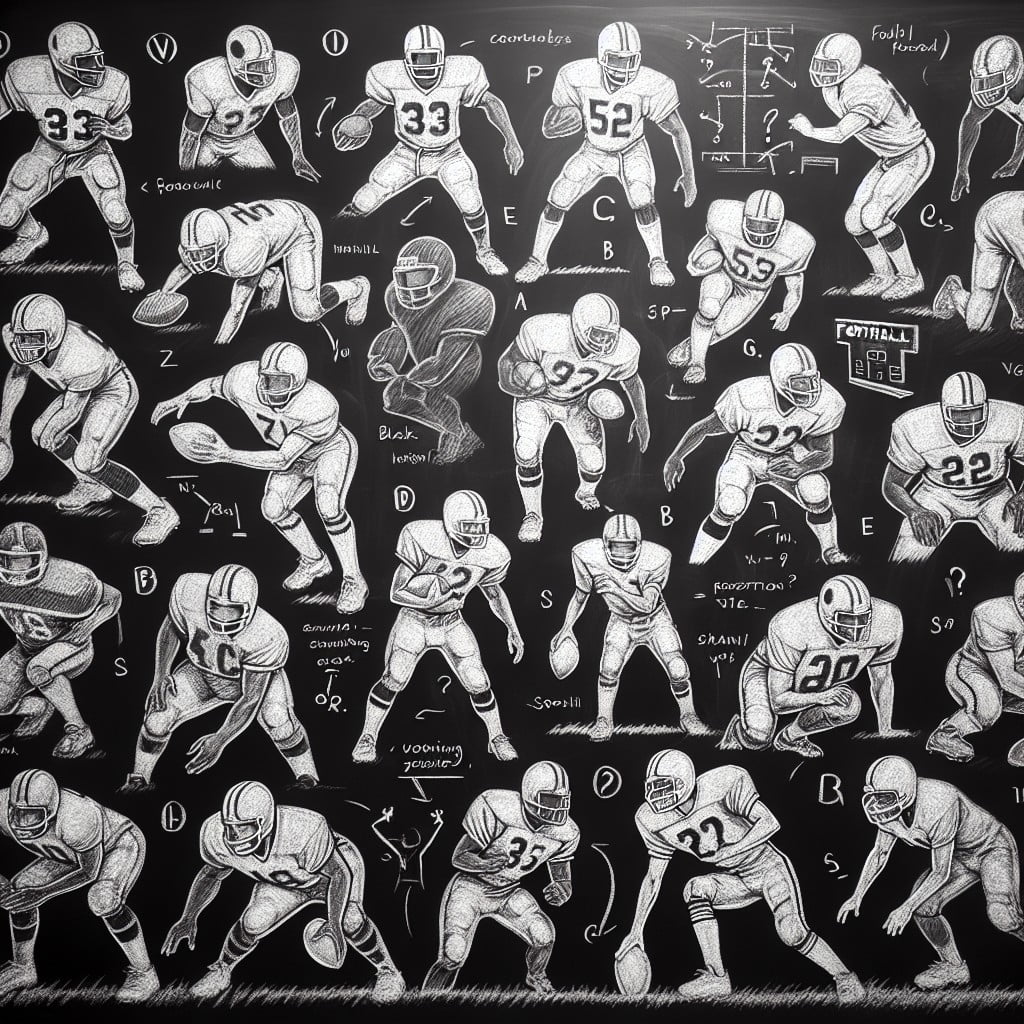
Turning your regular chalkboard into a source of entertainment can be an exciting venture. The Guess the Player game fosters both the competitive spirit and the football knowledge among participants.
Begin by sketching a silhouette or statistical profile of a renowned football player. Be sure to stick to minimal clues to increase the difficulty level.
Participants then stake their guesses and the one who correctly identifies the player gains a point. Not only does this fun game test your understanding of players’ statistics and physical characteristics, but it also serves as an engaging trip down memory lane, reminiscing famous players and their feats.
Video Replay Sketch
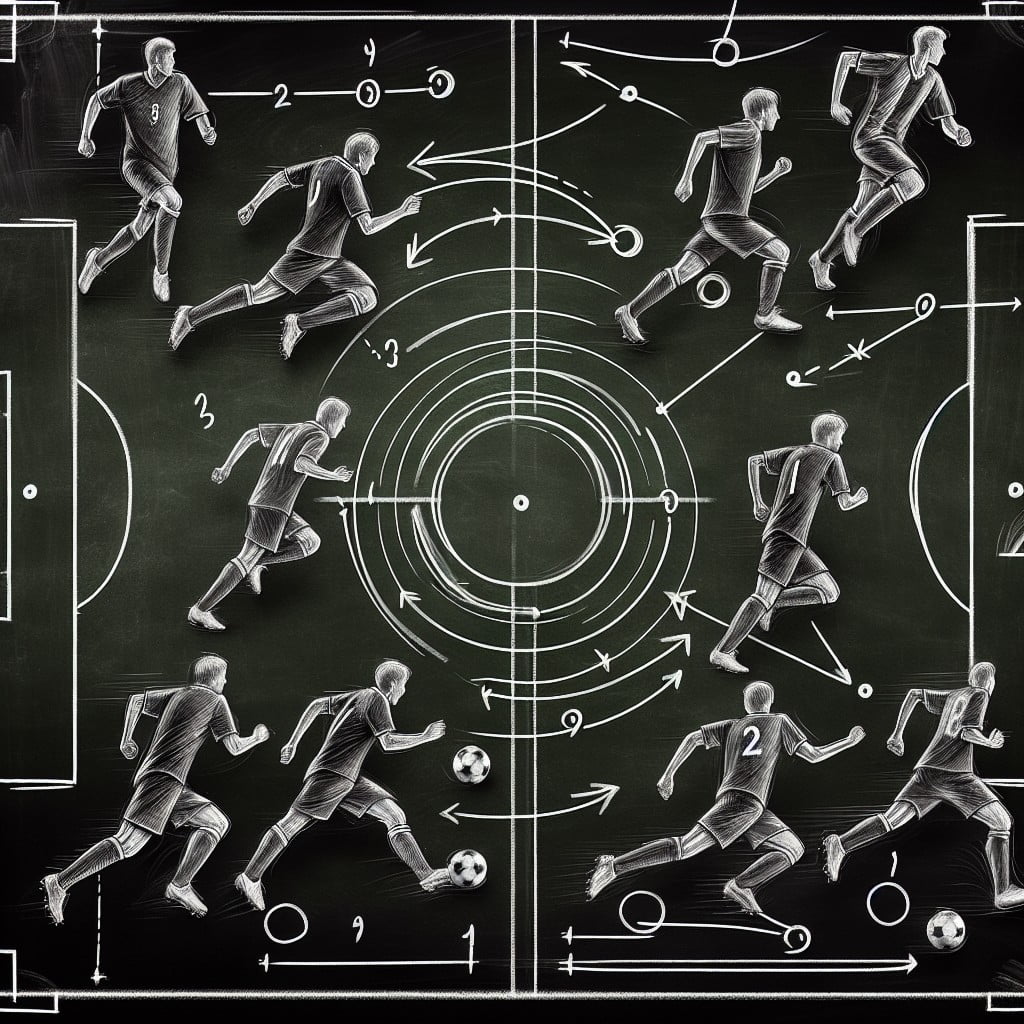
Harnessing the power of technology, creation of replays that can be sketched out offers a unique angle to analysis. Below, find engaging ways to utilize this approach:
1. Slow-Motion Analysis: Capture a significant motion or moment from a game. Slow it down and use the chalkboard to parse through the finer details that may get overlooked in real-time.
2. Play Breakdown: Choose moments that dictated the overall pace or outcome of the game. Clearly illustrate the setup, execution and results of the play for better understanding.
3. Player Focus: Highlight the outstanding performance of a particular player in the match. Break down their movements, contribution, and tactical decisions to appreciate their skill set.
4. Comparison: Compare two similar situations from different games. Analyze how different players or teams reacted, making distinct outcomes possible.
5. Predictive Analysis: Apply drawing out a replay approach to forecast an upcoming game’s movements. Make educated guesses on plays or strategies, aiding audience’s understanding of game dynamics.
Remember, this activity’s main purpose is to elucidate game complexities and foster deeper appreciation of the sport. Enjoy this novel way of reliving those heart-stopping moments.
League Table Updates
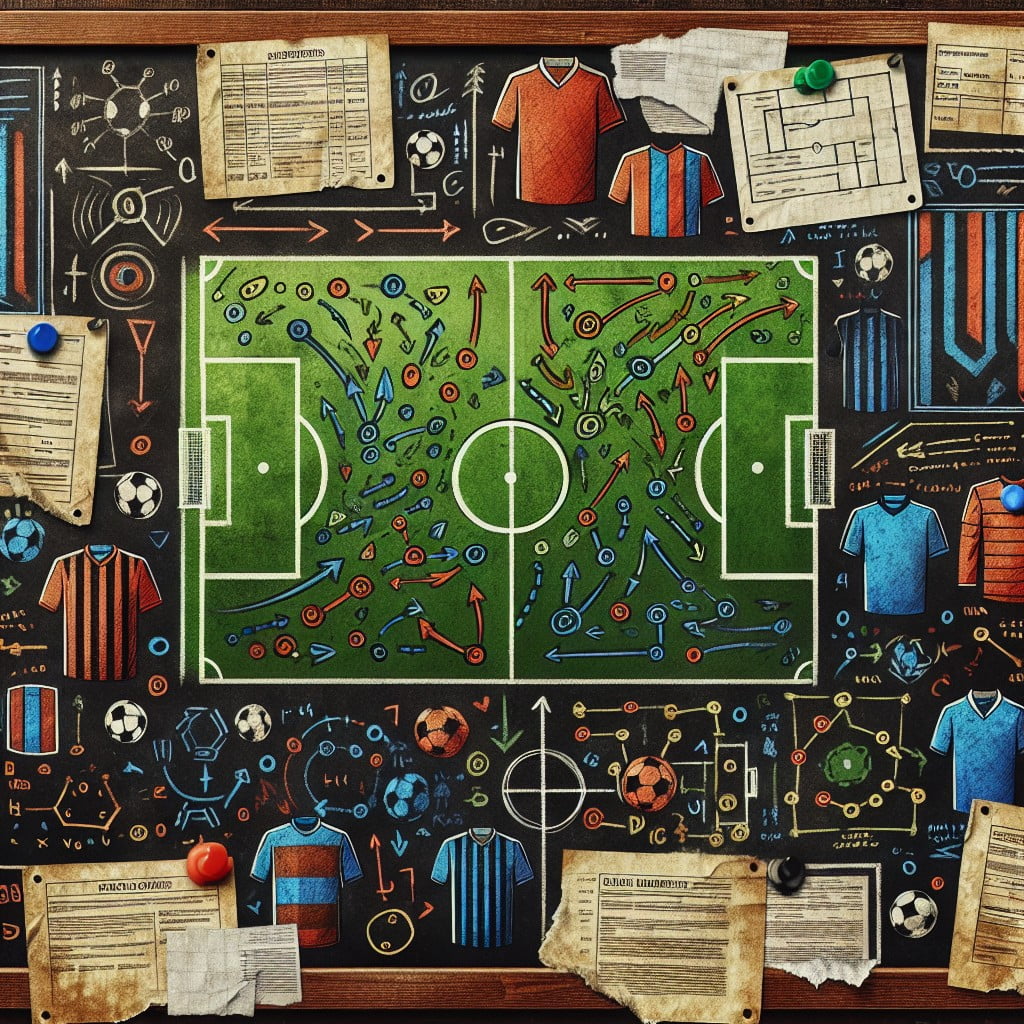
Staying updated with the standings is essential for any football enthusiast. A simple and straightforward way to do this is by dedicating a portion of your chalkboard for a league table.
Here are some points to keep in mind:
- Start with the team names and note their current position.
- Update the points as per the latest matches.
- Highlight key results, like unexpected wins or losses.
- Indicate the top scoring teams and the teams in relegation zone.
- Use colour codes for easier understanding – perhaps green for climbing and red for dropping in the standings.
This way, not only will you stay abreast of all the latest happenings, but your visualization will also help you analyse the shifts and find patterns in performances. It’s like bringing the excitement of the league right into your home! Plus, you may just find family members gradually getting involved, leading to interesting discussions and debates.
Key Match Moments Diagram
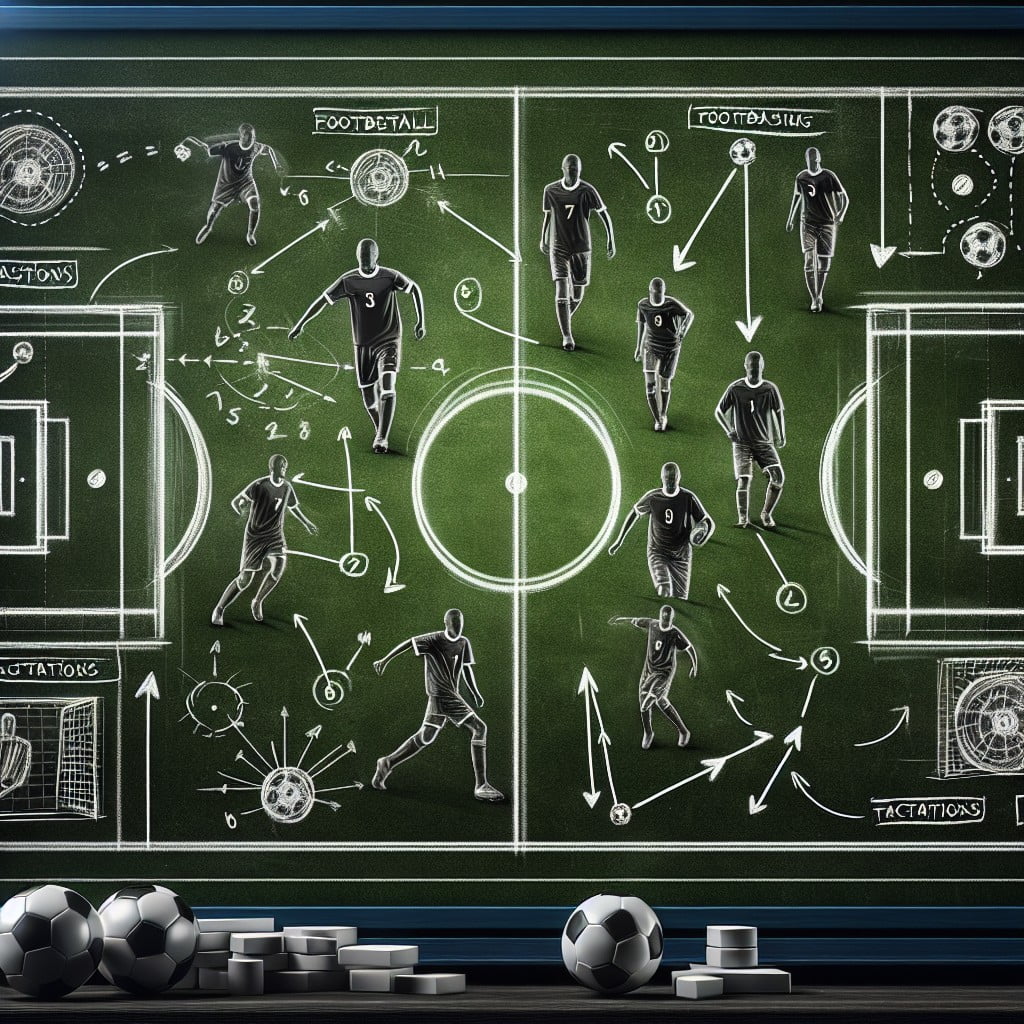
Getting a detailed visual of critical moments in a game can give you an edge as a football fan or player. With chalkboard diagrams, you can capture and dissect those game-changing instances.
Compose an illustration column for offense, defense, and special teams. Here’s how to get it started:
1. Determine Critical Moments: Select plays that altered the course of the match, whether positive or negative. Changes in possession, scoring plays, and turning points are some examples.
2. Sketch the Play: Follow the sequence of the moment, representing each player as an X (for the defense) or O (for the offense). Include movement arrows to show player paths.
3. Technical Details: Highlight the game clock, down number, and yard line, which can provide a clear picture of the situation.
4. Variation and Sub-Plays: Don’t limit yourself to the final play. Break down essential sub-plays that led to the crucial moment.
5. Diagram Analysis: Note the strategy involved. Did the defense play man or zone? Did the offense opt for a run or a pass? These details can help understand the team’s methodologies and decisions.
Remember, this is an engaging activity that enhances your comprehension of the game. Don’t stress about including every single detail, instead focus on the most influential factors. Above all, enjoy the process of retracing memorable plays from a strategist’s perspective.
Chalkboard Football Game Pictionary

Creating a unique spin on traditional Pictionary, this activity centers on the theme of football. An ideal choice for parties or game day gatherings, it’s an opportunity to test the drawing skills and football knowledge of participants.
Here’s how it works:
- 1. Prepare a list of football-related words or phrases. This might include player positions (like quarterback or cornerback), specific plays (like a hail mary or a flea flicker), or football terms (like touchdown or fumble).
- 2. Divide participants into teams and provide each with a drawing space on the chalkboard.
- 3. For each round, one team member should draw the assigned phrase or word without using letters or numbers while their team attempts to guess. The team with the most correct guesses wins.
Remember, the fun lies not only in the competition but also in the hilarious failed drawings and guesses. Keep the focus on enjoyment and bonding, and you’ll score a game day win with this engaging activity.
Favorite Players’ Autographs Imitation
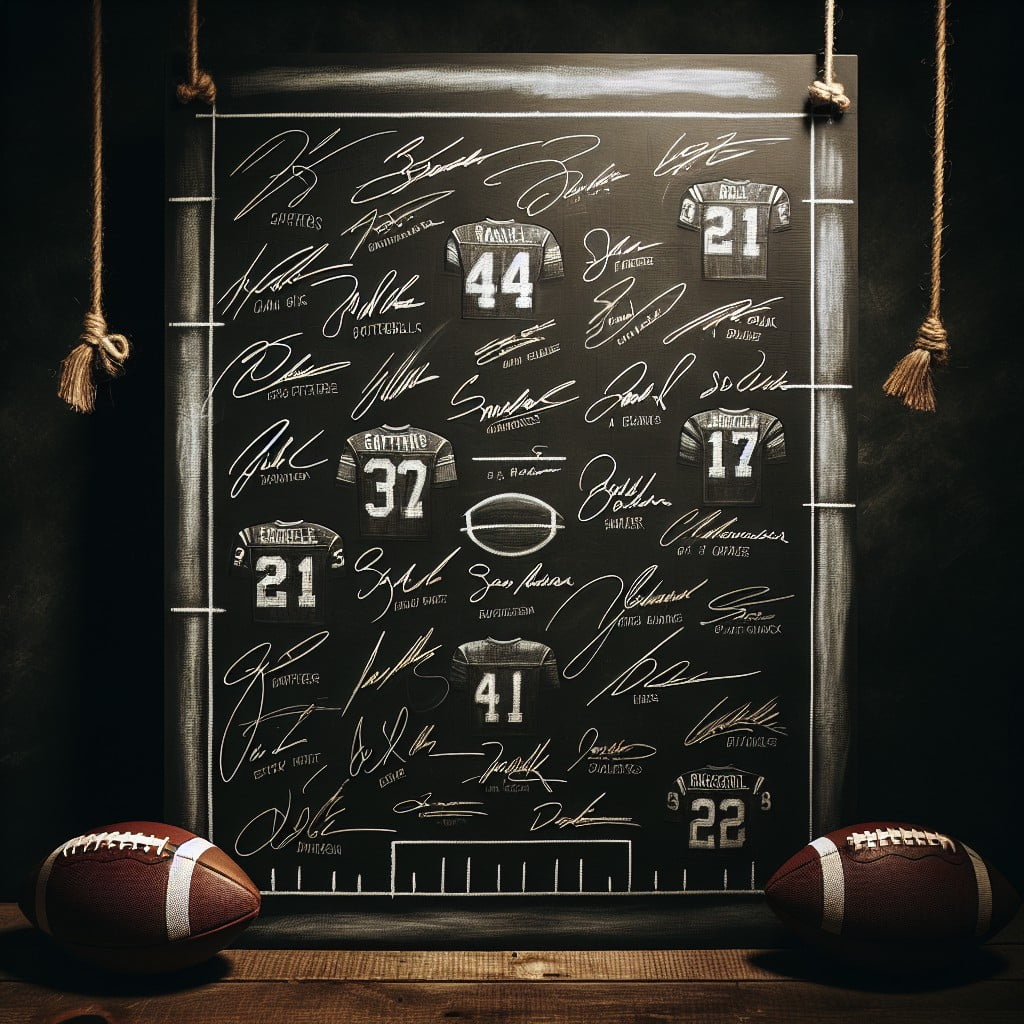
Emulating the autographs of favorite football stars can be both an entertaining and educational activity. All that’s needed is a picture or print of the player’s actual signature, some practice, and, of course, the chalkboard.
1. Find Clear Images: Look for the clearest, largest images of players’ autographs online, or from sports memorabilia.
2. Practice on Paper: Before attempting to draw on the chalkboard, practice on a piece of paper to get the feel of each unique swirl and line.
3. Emulate Signature: Once comfortable with the signature, move to the chalkboard, trying to mimic the pressure, slant, and style of the player’s signature.
4. Add Player Numbers: For more authenticity, add the players’ numbers beside their signatures.
5. Involve the Family: Turn this into a fun family activity by having everyone choose and imitate a favorite player’s autograph. It enhances the camaraderie and stimulates friendly competition.
Remember, the goal isn’t perfection but enjoyment and connecting with the exciting world of football.
Football-related Math Problems
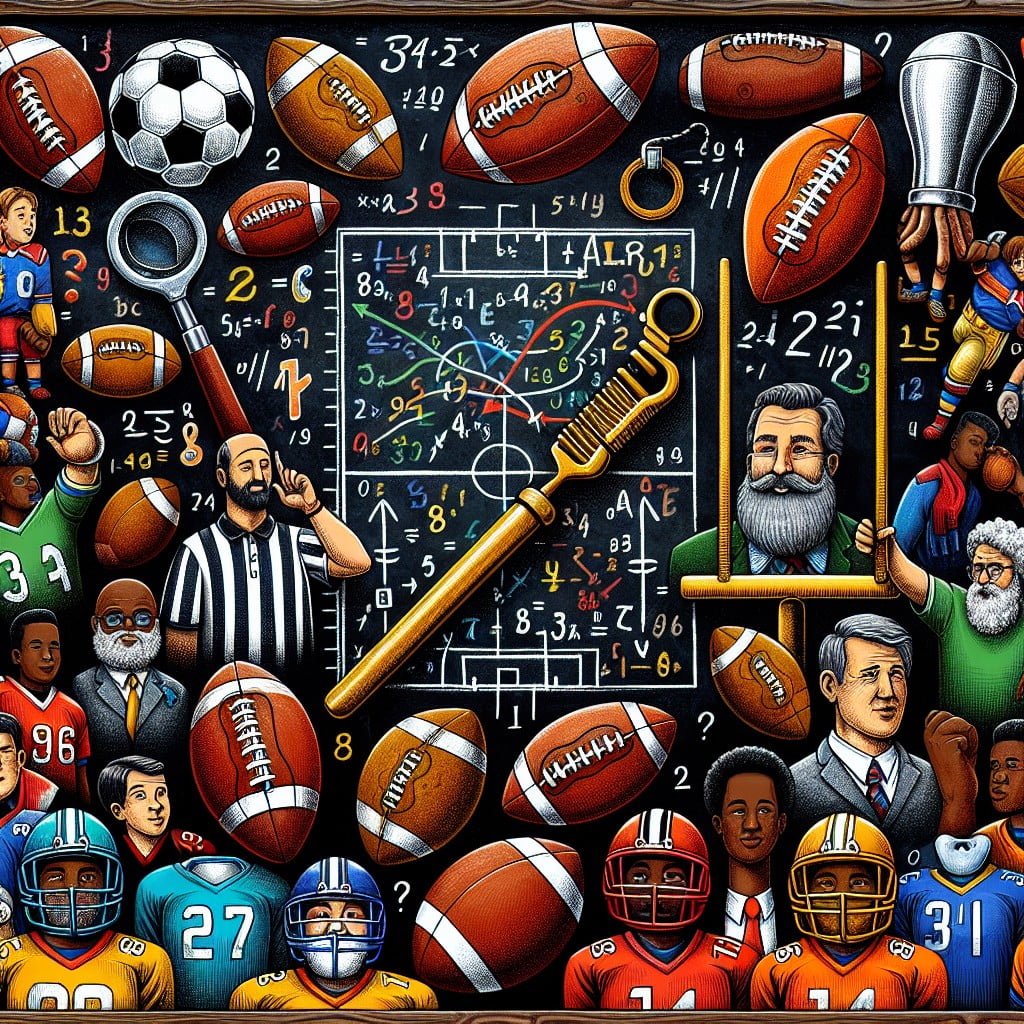
Delving into the world of numbers can make the football experience even more exciting. Forget your everyday math problems — we’re talking statistics, probabilities, and patterns that help forecast the outcome of a match or a player’s performance.
1. Player Statistics: Compare statistics for different players, analyzing metrics such as goals scored, assists, or interceptions in a given season.
2. Probability Predictions: Use past match results to predict the likelihood of a particular outcome in a future game.
3. Game Patterns: Identify regular patterns, such as the frequency of a team scoring in the last 15 minutes.
4. Yard Comparison: Consider the total yards a team passes or runs for in different matches, drawing conclusions about their attack and defense strategies.
5. Score Predictions: By looking at average points scored and conceded over past games or seasons, you can make educated guesses about future match scores.
Remember, though, that while these methods inject a little fun into the game and may increase your understanding, they can’t guarantee future results. After all, football remains a beautifully unpredictable sport.
Referee Signals Explanation

Understanding each referee signal can significantly enhance football viewing pleasure. The most common signals include touchdown, safety, and penalty.
Here they are as follows:
- Touchdown: Referee extends both arms horizontally.
- Safety: Referee places palms together above his head, creating a triangle.
- Holding Penalty: Referee clenches a fist, extends arm in front emphasizing a grip.
- Offside: Referee arms form a V shape and are quickly pushed outward.
- Delay of Game: Referee moves his arms horizontally in a motion mimicking a clock’s hands.
Draw these signals and marshal your troops through a quick football match with roles reversed. Let them take turns to be the ‘referee’ correct signaling. It adds surprising fun dynamics to the chalked out football strategies.
Motivational Pre-game Speech

A captivating pre-game speech on your football chalkboard can be the element that takes the team’s morale to the next level. Ideating one doesn’t have to be daunting.
1. Theme: Your chalkboard speech should have a theme. It could reflect determination, teamwork, or belief. Pick an idea and build your speech around it.
2. Structure: A clear structure ensures your speech is easy to follow. Typically, this involves an opening statement, the body where you lay out the main points with supporting details, and a striking ending.
3. Visuals: Enhance your speech with diagrams, images, or relevant quotes. Visuals clarify the message, making it easier to understand and remember.
4. Confidence Boosters: Incorporate phrases that instill confidence. This can instigate a positive mental attitude among team members.
5. Keep it Short: Lasting only a few minutes, an ideal pre-game speech is concise, impactful, and energetic.
Remember to engage everyone and promote the spirit of the game. Most of all, make it personal – think of what would resonate the most with your team and use that as a basis. After all, the goal is to motivate the team to give their best on the field.
Ideas Elsewhere
- https://timber2glass.com/products/wall-chalkboard-decor-football
- https://www.framedart.com/sports-mania/american-football-field-chalkboard-print-937016.htm
- https://www.shutterstock.com/search/soccer-chalkboard-art
- https://thismakesthat.com/super-bowl-chalkboard/
Recap:




